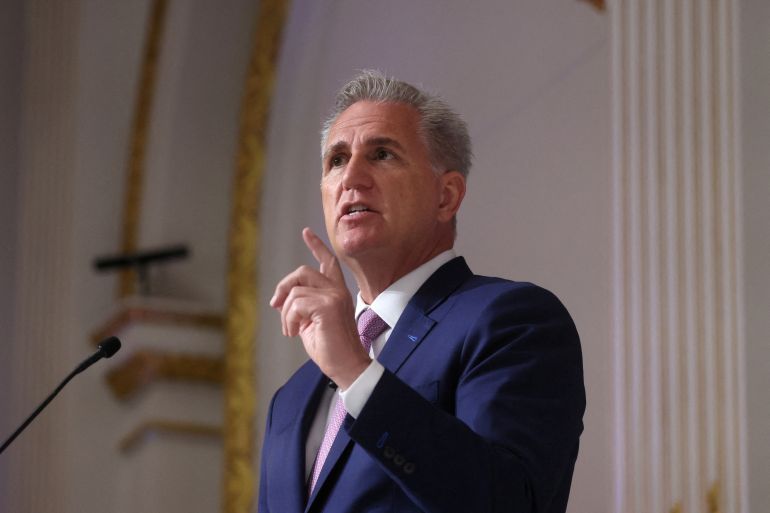What’s in US House Speaker Kevin McCarthy’s debt-limit package?
The Republican leader has introduced a proposal to slash government spending along with increasing the federal debt limit.

United States House of Representatives Speaker Kevin McCarthy has unveiled a bill that would pair $4.5 trillion in spending cuts with a $1.5 trillion increase in the federal debt limit.
The newly revealed plan lays out McCarthy’s opening position in what is likely to be a tense partisan debate over government borrowing. Here is a summary of what was released on Wednesday:
Keep reading
list of 3 itemsIn another round of cuts, Facebook parent Meta sacks tech teams
Tesla’s profit margins drop on aggressive discounts, shares fall
Debt ceiling increase
McCarthy’s bill would suspend the nation’s borrowing limit, currently at $31.4 trillion, until March 31, 2024 or until it increases by another $1.5 trillion — whichever comes first.
At that point, Congress would have to address the issue again as the 2024 presidential campaign heats up.
Spending restraint
The plan would dial back the amount of spending Congress approves annually to the $1.47 trillion approved in the fiscal year that ended on September 30. It would also cap spending growth to 1 percent annually over the next 10 years.
Those limits would effectively serve as spending cuts as they would not keep up with projected inflation and population growth.
Within that figure, legislators would still have to sort out how much to devote to the Pentagon and to domestic agencies like the Environmental Protection Agency, a perennial partisan flashpoint.
Congress agreed to similar spending caps in 2011 during another debt-ceiling standoff, though it often did not adhere to them in the following years.
The caps would not apply to benefit programmes such as Social Security and Medicare, which are projected to grow dramatically as the population ages.
Claw back unspent COVID-19 funds
The plan would cancel the remaining pots of money from the $5.2 trillion that Congress approved between 2020 and 2022 to fight COVID-19. According to the White House, the remaining money amounted to less than $80bn in January and is likely lower now.
Most of that money is earmarked for troubled union pension funds, veterans’ healthcare and medical research.
Cancel student debt relief
McCarthy’s proposal would scrap Democratic President Joe Biden’s effort to cancel roughly $400bn in student debt, which Republicans have portrayed as unfair to those who did not go to college or already paid off their debts.
The Supreme Court is expected to rule on whether that plan is legal before July.
Cut IRS funding
The plan aims to rescind an $80bn investment plan for the Internal Revenue Service (IRS), which the tax-collecting agency will use to hire more employees and deploy new technology.
But the nonpartisan Congressional Budget Office projects the new IRS funding will generate about $204bn through increased enforcement.
Repeal green tax incentives
It would repeal incentives for renewable energy, electric vehicles and other climate-friendly technology that Democrats passed last year as part of the Inflation Reduction Act.
Tighten work requirements
The plan would stiffen work requirements for participants in the Supplemental Nutrition Assistance Program (SNAP) programme, which provides grocery money to low-income people.
Increased authority over regulations
It would give Congress greater power to review new rules put forward by the executive branch, potentially giving Republicans more power to block environmental and workplace regulations, among others they see as harmful.
More incentives for oil and gas
McCarthy’s package includes a sweeping fossil-fuel bill that passed the Republican-controlled House in March but stalled in the Democratic-controlled Senate.
The bill aims to bolster oil and gas production by reducing relations, promoting energy development on federal lands and eliminating Democratic-backed climate incentives.